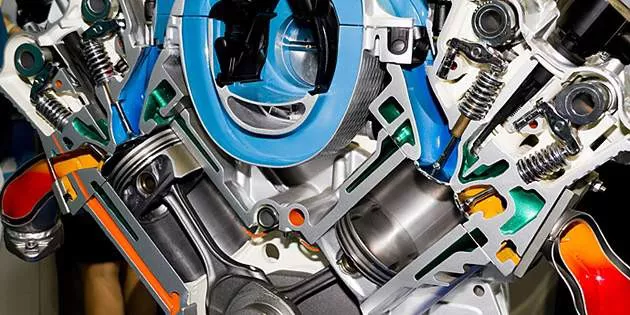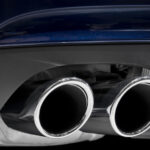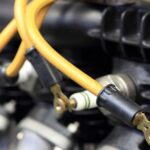The efficiency of the engine depends to a large extent upon the following criteria:
| · Compression | |
| · Combustion Process | |
| · Air/Fuel Mixture | |
| · Mechanical Design | |
| · Lubrication |
1) Compression
The higher the Compression Ratio or the pre-compression pressure, then the higher is the thermal efficiency of the internal combustion engine. This results in a better fuel usage and more power is developed while less fuel is consumed. The maximum compression is however limited by the Octane Rating of the Gasoline that will be used. The higher the Octane Rating the higher the compression can be.
Unfortunately, higher Octane Gasoline costs more to produce than low Octane Gasoline. Therefore the increase in fuel efficiency can be offset by increase in fuel costs.
The Compression Ratio is based on the mechanical design of the engine and is expressed as:

Where:
e = Compression Ratio
Vh = Cylinder swept Volume
Vc = Combustion space Volume of Cylinder
Even more important than Compression Ratio is the actual pre-compression pressure also called Final Compression Pressure. Although its value can be also described and figured out mathematically, it is always substantially less than the mathematical result. The actual Final Compression Pressure can be reliably obtained only by a measurement with a special tool, the Compression Tester.
It is however important to know what the Final Compression Pressure should be for the particular engine. This specification can be usually found in a “Shop Manual” for the particular engine. The difference between the measured and specified values for the Final Compression Pressure determines the “Sealing Quality” of the combustion chamber.
The quality of the combustion chamber sealing by means of the Piston Rings and the Valves is a measure of the condition of the engine. Lubricant can also affect the quality of the sealing between the Rings and the Cylinder bore.
When the Final Compression Pressure is too high on a used engine, it usually means that the combustion chamber and the piston crown have excessive amounts of carbon deposits that have been formed due to any of the following:
1. Incomplete combustion
2. Use of poor quality fuel
3. Use of poor quality lubricant
If the Final Compression Pressure is too low on a used engine, it usually means that the engine has any of the following problems:
| Has excessive amount of cylinder wear (due to poor lubrication) | |
| Has sticking piston rings (poor lubricant) | |
| Has burned exhaust valves (poor fuel or incorrect ignition timing) | |
| Has damaged cylinder head gasket | |
| Has sticking intake or exhaust valves (poor lubricant) |
2) Combustion Process
For the quality of the combustion process it is of prime importance that the fuel mixes intimately with the air, so that it can be burnt as completely as possible. It is important that the flame front progresses spatially and in regular form during the power stroke, until the whole mixture has been burnt. The combustion process is considerably influenced by the point in the combustion chamber at which the mixture is ignited, and by the mixture ratio as well as the manner in which it is fed into the combustion chamber.
Combustion is optimal and the efficiency of the engine is at its best when the residual gases contain no unburned fuel and as little of Oxygen as possible. The Hydrocarbons are broken up during the combustion into their constituent parts, they are Hydrogen and Carbon. On complete combustion the Carbon and Hydrogen burn to form Carbon Dioxide and Water vapor. When the combustion is incomplete the exhaust gases also contain other undesirable constituents.
3) Air/Fuel Mixture
The Specific Fuel Consumption of an engine is defined as the amount of energy produced per given amount of fuel consumed in the combustion process. The amount of fuel is quoted in grams or kilograms and the amount of energy produced in Kilo-Watt-Hours or Horsepower per hour.
Internal combustion engines can consume as little as 300 grams per kWh or as much as 1,200 grams per kWh.
In general the Specific Fuel Consumption is at its greatest (least efficient) when the engine is subjected to low loads, such as idle. This is because the ratio between the idling losses (due to friction, leaks, and poor fuel distribution) and the brake horsepower is the most unfavorable.
Most engines have the lowest Specific Fuel Consumption at three-quarter load, which is at 75% of the maximum power output and at about 2,000 RPM.
The Specific Fuel Consumption of engine is for the most part dependent on the mixture ratio of the Air/Fuel mixture. Consumption is at its lowest with an Air/Fuel Ratio of approximately 15 pounds of Air to one pound of Fuel. This means that 10,000 gallons of Air are needed to burn one gallon of Gasoline.
4) Mechanical Design
The mechanical design of the internal combustion engine has not changed since its conception in 1876, mainly because it works. The problem is, that it has been invented long before there was thorough understanding of thermodynamics or of the chemical reactions during combustion process. Further cheap and plentiful fuel — Gasoline was easily available and until few years ago there was no concern with conservation or pollution.
As a result the internal combustion engine is an energy efficiency dinosaur that refuses to die.
To give you some idea why that is so, let’s consider this:
Gasoline contains about 42 to 43.5 Mega-Joules of energy in one Kilogram that is equal to about 18,060 to 18,705 Btu per pound.
The pie chart on next page will show you where all that energy that is available in Gasoline goes:


